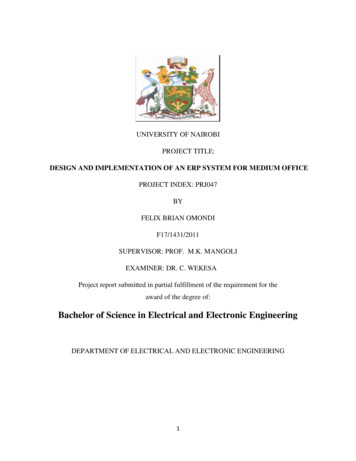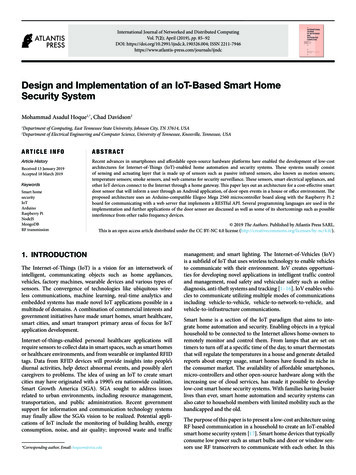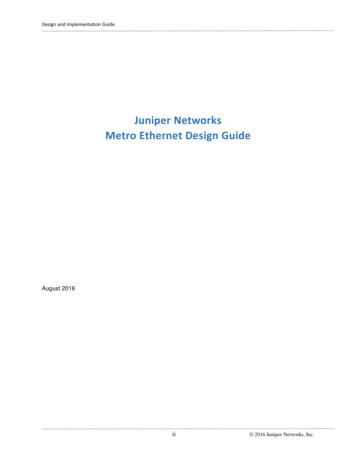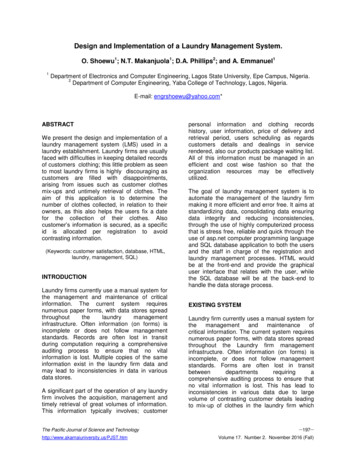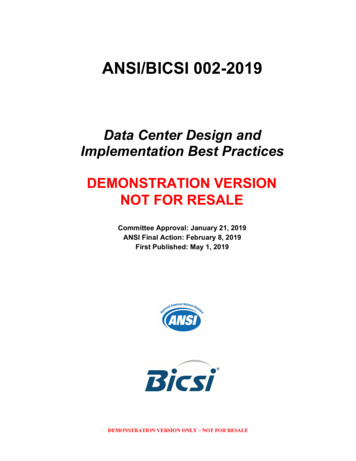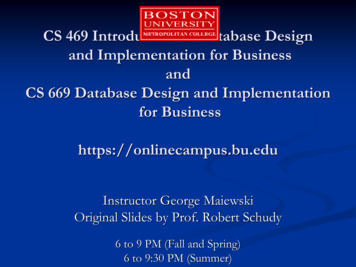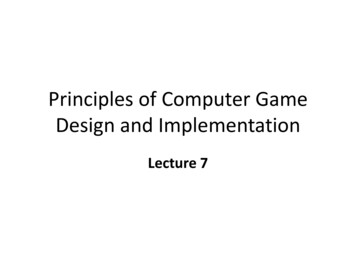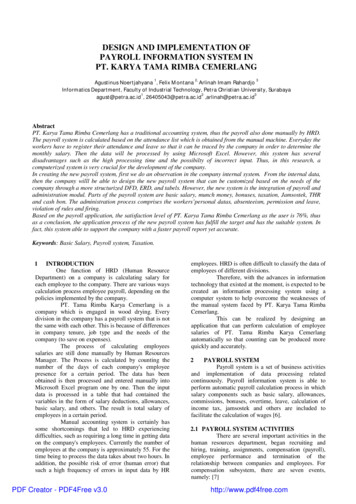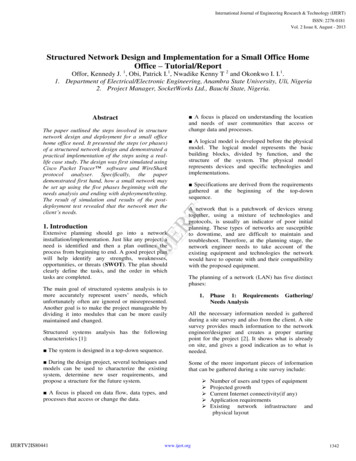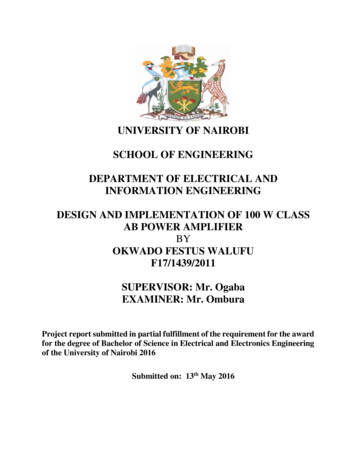
Transcription
UNIVERSITY OF NAIROBISCHOOL OF ENGINEERINGDEPARTMENT OF ELECTRICAL ANDINFORMATION ENGINEERINGDESIGN AND IMPLEMENTATION OF 100 W CLASSAB POWER AMPLIFIERBYOKWADO FESTUS WALUFUF17/1439/2011SUPERVISOR: Mr. OgabaEXAMINER: Mr. OmburaProject report submitted in partial fulfillment of the requirement for the awardfor the degree of Bachelor of Science in Electrical and Electronics Engineeringof the University of Nairobi 2016Submitted on: 13th May 2016
Declaration of OriginalityFACULTY/ SCHOOL/ INSTITUTE: EngineeringDEPARTMENT: Electrical and Information EngineeringCOURSE NAME: Bachelor of Science in Electrical & Electronics EngineeringNAME OF STUDENT: Okwado Festus WalufuREGISTRATION NUMBER: F17/1439/2011COLLEGE: Architecture & EngineeringTITLE OF WORK: DESIGN OF 100W CLASS AB POWER AMPLIFIER1) I understand what plagiarism is and I am aware of the university policy in this regard.2) I declare that this final year project report is my original work and has not been submittedelsewhere for examination, award of a degree or publication. Where other people’s work or myown work has been used, this has properly been acknowledged and referenced in accordance withthe University of Nairobi’s requirements.3) I have not sought or used the services of any professional agencies to produce this work.4) I have not allowed, and shall not allow anyone to copy my work with the intention of passing itoff as his/her own work.5) I understand that any false claim in respect of this work shall result in disciplinary action, inaccordance with University anti-plagiarism policy.Signature: Date: Approved by:Supervisor: Mr. OgabaSignature: Date i
DedicationTo my family especially my dad, Mr. Matthew Ademba and my mum, Mrs. Magdalene Wangatiafor their relentless support in my University education.ii
AcknowledgementI would like to express my heartfelt gratitude to Mr. Ogaba, who was my supervisor, for hisconstant guidance in the implementation of this project.I would like to express great gratitude to all the lecturers in the Electrical Engineering department,University of Nairobi for equipping me with all the knowledge and skills that provided enoughcompetence to complete the project.I would also like to acknowledge my examiner, Mr. Ombura for taking his time to examine thisproject.Thirdly, I would like to thank members of staff in the Electrical department including Mr. Rotichfor providing support in acquisition of components and Mr. Wangai of mechanical workshop forhis assistance in making of the PCBFinally, I would like to thank my classmates & colleagues especially David Kibet, GideonMwendwa, Khaemba John and Tonny Silvance for their much valued advice and great contributiontowards the success of the project.Above all, I would like to thank the almighty God for enabling me achieve this success andshowing me light at the end of the tunnel.iii
Table of ContentsDeclaration of Originality . iDedication . iiAcknowledgement . iiiChapter one: Introduction . 11.1History of power amplifiers . 11.1.1 Vacuum tubes versus solid state designs . 11.2Objectives . 21.2.1 Main project objective . 21.2.2 Specific project objectives . 21.3Problem statement . 21.4Project scope . 2Chapter two: literature review . 32.1Audio Power Amplifier . 32.2Basic performance specifications of audio amplifier . 32.2.1 Amplifier distortion . 32.2.2 Frequency response . 42.2.3 Signal to noise ratio . 42.2.4 Output power . 52.2.5 Slew Rate . 52.3Power amplifier stages. . 62.3.1 Input Stage . 72.3.2 Voltage Amplification Stage. 92.3.3 Output stage . 132.4Protecting the Amplifier and Loudspeaker . 162.4.1 Loudspeaker Protection . 162.4.2 Short Circuit Protection . 172.5FILTERS . 172.5.1 Passive Filters versus Active Filters . 172.5.2 Band Classifications of active filters . 182.5.3 Filter optimization. 192.5.4 Quality Factor Q . 21iv
Chapter three: Methodology and circuit design . 223.1Circuit design . 223.1.1 Output Stage. 233.2Voltage amplification stage . 273.2.1 Design of bootstrap . 283.2.2 Design of Bias Servo . 293.3Input stage . 303.4Design of three way active crossover network. 343.4.1 Design of Low Pass filter . 353.4.2 Design of high pass filter . 363.4.3 Design of band pass 2nd active order filter . 373.4.4 Design of preconditioning circuit . 39Discussion and Conclusion . 40Recommendation . 40References . 40Table of FiguresFigure 1: Long Tail Pair Circuit. 7Figure 2: Single Transistor Circuit . 8Figure 3: Class A driver Circuit . 9Figure 4: Simple Current Source Using voltage divider Circuit. 10Figure 5: Current source using LED Circuit . 11Figure 6: Bootstrap Current Source circuit . 11Figure 7: Bias servo circuit . 12Figure 8: Complementary Feedback Pair (CPF) Circuit. 14Figure 9: Darlington complementary symmetry output Circuit . 15Figure 10: Quasi-Complementary symmetry output Circuit . 16Figure 11: A second order high pass filter Circuit . 18Figure 12: A second order low pass filter Circuit . 19Figure 13: A second order band pass filter Circuit . 19Figure 14: Butterworth response graph. 20Figure 15: Chebshev response curve . 21Figure 16: Class AB power amplifier with CFP Circuit . 24Figure 17: VAS stage circuit design . 28Figure 18: Input stage design circuit . 31v
Figure 19: second order low pass filter circuit diagram with cutoff frequency (f1) 1.2 KHz. . 35Figure 20: second order high pass filter circuit diagram with cutoff frequency (f2) 5 KHz. . 36Figure 21: band pass filter with cutoff frequency of 1.2 KHz and 5 KHz respectively . 37Figure 22: Preconditioning circuit . 39vi
Chapter one: Introduction1.1 History of power amplifiersVacuum tubes (valves) amplifiers were by far the dominant until the 1960s, whensemiconductors (transistors) started taking over for performance and economic reasons,including heat and weight reduction and improved reliability. At first all silicon power transistorswere NPN, and for a time most transistor amplifiers relied on input and output transformers forpush-pull operation of the power output stage. These transformers were as always heavy, bulky,expensive, and non-linear, and added insult to injury as their LF and HF phase-shifts severelylimited the amount of negative feedback that could be safely applied. Proper complementarypower devices appeared in the late 1960s, and full complementary output stages soon proved togive less distortion than their quasi-complementary predecessors as mentioned in [1].1.1.1 Vacuum tubes versus solid state designsThe following are disadvantages of vacuum tubes over solid state audio amplifiers as mentionedin [2]1. Vacuum tube amplifiers cost from 3 to 10 time as much as solid-state designs.2. Vacuum tubes are heavier and bulkier than solid state designs3. Vacuum tubes are more fragile compared to solid state4. Vacuum amplifier do not provide any protection against continuous short-circuitconditions at the output5. Vacuum tubes amplifier waste more energy than solid state designs, due to the necessityof heating the tube filaments.1
1.2 Objectives1.2.1 Main project objectiveThe main objective of this project was to design a 100W power amplifier with feedbackpair complementary symmetry output power transistors.1.2.2 Specific project objectives To design three class AB power amplifiers with feedback-pair complimentarysymmetry output driven by an active 3-way cross-over network and a pre-amplifier. The total power of the three power amplifiers should some up to a total of 100Weach driving a resistive load of 8 ohms. The filters making up the active network should be second order with Butterworthresponse comprising of Sallen-Key Topology.1.3 Problem statementMany power amplifiers are affected by noise and distortion. A simple class AB poweramplifiers with feedback-pair complimentary was designed to overcome the mentionedproblems.1.4 Project scopeClass AB power amplifiers with feedback-pair complimentary was designed. The designedcircuit was the simulated using Protues software. The resu
The total power of the three power amplifiers should some up to a total of 100W each driving a resistive load of 8 ohms. The filters making up the active network should be second order with Butterworth response comprising of Sallen-Key Topology. 1.3 Problem statement Many power amplifiers are affected by noise and distortion. A simple class AB power

